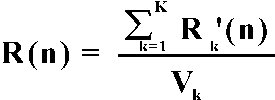Mean Value Analysis

Three operational laws and an iterative series of calculations provide the throughput and response time of the system, as well as information about utilization and degree of multiprogramming of the system is 0 (n = 0). When there
is no multiprogramming, the queue length at each server is 0. If the
model represents a closed system, the degree of
multiprogramming is the load on the system. The visit ratio (V, with subscript i, refers to server i)
and mean service time (S, with subscript i, refers to
server i) are known for each server .
To perform the mean value analysis
- Figure the average residence time for each server. The
average residence time of a server is the time a transaction spends at a
server during all of its visits.


is called the service demand on a server.
Click here for further information about how this step was derived.
- Use the total of average residence times for all servers to
calculate the system throughput at degree of multiprogramming level = n.

Click here for further information about how this step was derived.
- By applying Little's Law, the queue length for the current multiprogramming level can be derived for each server.

- Increment n and repeat steps 1 - 3 until n > the actual degree of
multiprogramming. The system throughput was calculated in step 2. The
system response time is
 The Utilization Law and the Forced Flow Law can be applied to information obtained from the mean value analysis, in order to determine additional system performance measures.
The Utilization Law and the Forced Flow Law can be applied to information obtained from the mean value analysis, in order to determine additional system performance measures.
[M2]








